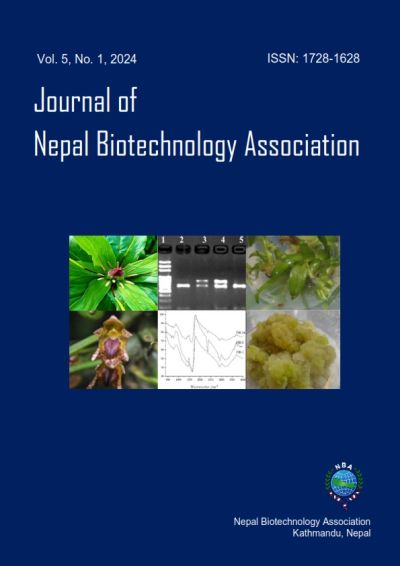Pharmacological Activities of Six Species of Hedychium J. Koenig from Nepal
DOI:
https://doi.org/10.3126/jnba.v5i1.63743Keywords:
Biological activity, Rhizome extract, Hedychium, HimalayaAbstract
Species of Hedychium Koenig are perennial herbs. Some of the species like H. ellipticum, H. spicatum, H. coronarium are traditionally used as medicinal plants. In the present study, methanolic rhizome extracts of six different species of Hedychium namely H. spicatum, H. ellipticum, H. thyrsiforme, H. coccineum, H. gardnerianum and H. coronarium were analysed for their antioxidant, antidiabetic and antibacterial activities. The antioxidant activity analysed by DPPH assay showed the highest potential (lowest IC50 value) in H. coccineum (148.82±2.83 µg/ml) and lowest potential (maximum IC50 value) in H. thyrsiforme (996.55±9.42 µg/ml). The rhizome extracts of different species showed moderate α-amylase inhibition activity in vitro. The highest α-amylase inhibition (79.67%) was observed for H. coronarium while the lowest inhibition (64.0%) was observed in H. thyrsiforme. However, these values were found lower than the value (92.37%) obtained for positive control, i.e., Acarbose. The antibacterial activity was determined against two Gram-positive (Bacillus subtilis and Staphylococcus aureus) and two Gram-negative (Klebsiella pneumoniae and Pseudomonas aeruginosa) bacterial strains by agar well diffusion method. Except for H. ellipticum the extracts of all other species showed antibacterial activity against all the bacterial strains tested. The extracts of H. ellipticum showed antibacterial activity only against B. subtilis and K. pneumoniae. The extract of H. coronarium showed the highest zone of inhibition (16.67±1.15 mm) against B. subtilis. However, the antibacterial activity was weak compared to standard antibiotics for all the extracts and at all concentration tested. These results show that rhizomes of other species can also be used in the same manner as that of H. coronarium and H. spicatum, two species most used in various ethnomedicinal applications.




